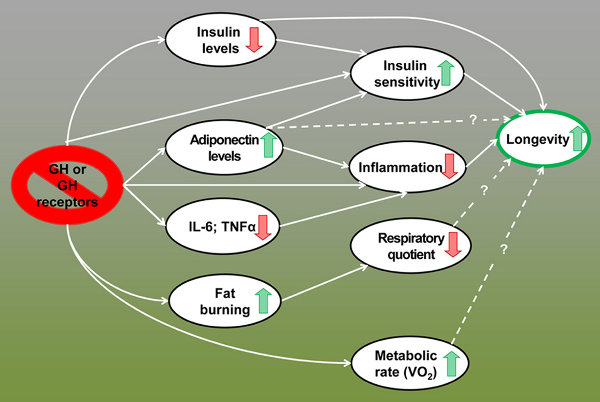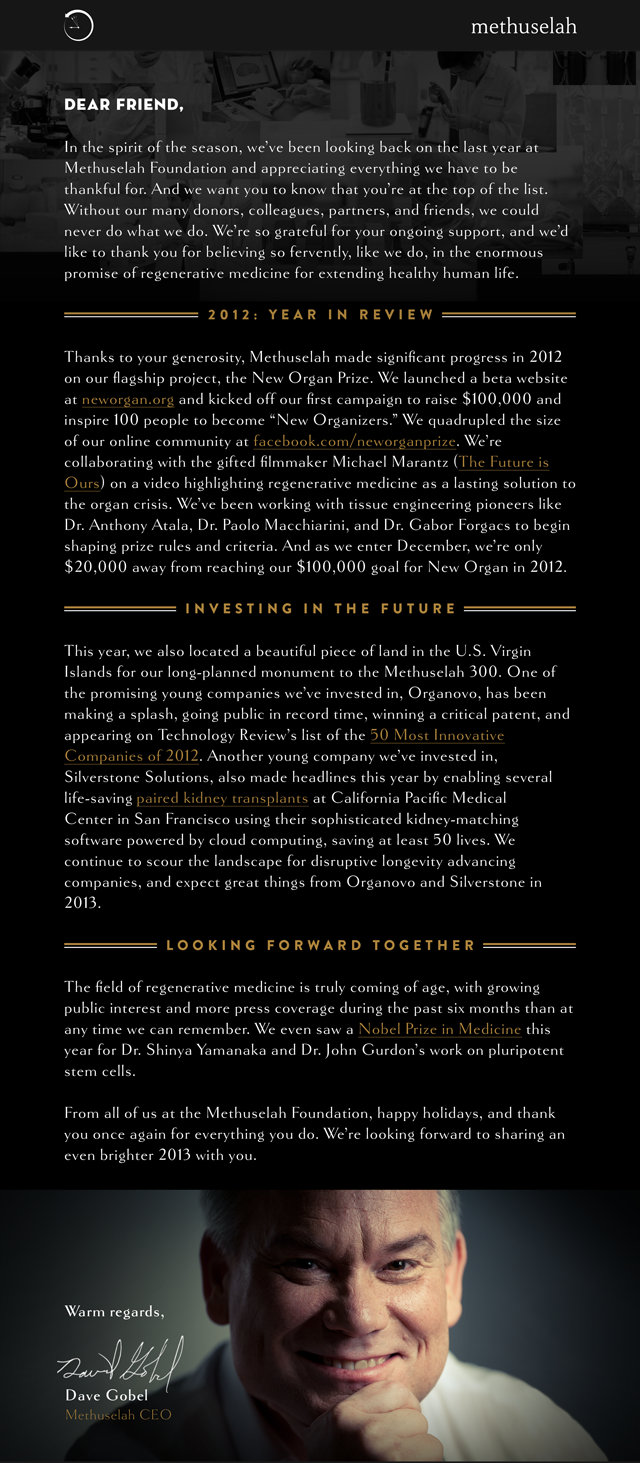Looking Back at 2012
That was 2012: another year closer to both the grave and the rejuvenation biotechnology to keep us out of it. This is very much a race, but one in which we can all do our part to help the right horse win. Research runs on money and popularity - but mostly money. Every little bit helps.
Conferences, as usual, abounded this past year. Noting only a few, there was the Alcor 40 conference, the Eurosymposium on Healthy Aging, Humanity+ conferences in Melbourne and San Francisco, the Singularity Summit, and the International Conference on the Genetics of Aging and Longevity.
The cryonics community has, pleasantly, continued with the trend of receiving better and more positive coverage in the press, as well as from the medical community. Another of the original leaders of the US cryonics community was cryopreserved earlier in the year, while the establishment of a new cryonics provider in Australia appears to be moving ahead. On the scientific side of things, the Brain Preservation Foundation's research prize is beginning to generate concrete results.
This has been in year in which the longevity science community over in Europe and Russia have set themselves to form single-issue political parties, a strategy for advocacy that has seen some success for other causes. An International Longevity Alliance umbrella organization was formed, and we should no doubt expect to see more on this front over the next few years.
Speaking of Russia, there has been more press this past year for the ongoing 2045 initiative, including an interview with the wealthy founder. We shall see where this all goes, but to my mind the best thing that could happen here is for the fellow to change his mind about strategy and begin to put his weight behind SENS research rather than the current robotics and mind-machine interface approach. Time is too short to make the latter work rapidly enough.
The wave of Kickstarter clones has led to many organizations that are trying to bring crowdsourced funding to scientific research. I applaud this goal, and have absolutely no idea how they are going to make it work - I hope that someone cracks the code and finds a good general, supportive methodology that can lead to better results in funding for research projects like SENS, or organizations like the Methuselah Foundation, or for community initiatives like those at Longecity. If it's going to happen, it will happen in 2013 or 2014 - if not by then, I think these scientific crowdfunding initiatives will die back for a decade before someone tries again.
The Glenn Foundation expanded its ongoing support for mainstream longevity science this year, establishing labs at Princeton and the Albert Einstein College of Medicine.
The SENS Foundation released their 2011 annual report and research report, building on the impressive 2010 progress. Research on the foundations of rejuvenation biotechnology is progressing, and we can hope that the larger philanthropic and institutional fundraising efforts continue to expand alongside their growing Academic Initiative. On the scientific side, new results were published a few months back for LysoSENS bioremediation research - finding bacterial enzymes that can safely break down harmful metabolic byproducts that build up in cells. Co-founder and scientist advocate Aubrey de Grey participated in a number of noteworthy events in 2012, such as the Oxford University Science Society public debate, and a seminar chaired by Peter Singer that later led to a fairly favorable article by that bioethicist. De Grey also put forward some updated cost and time estimates for the SENS program as presently envisaged.
The Methuselah Foundation has focused on tissue engineering and the New Organ Prize, continuing their establishment of a crowdsourced fundraising initiative to speed development of organs produced to order from a patient's own cells. You might take a look at an interview with David Gobel from ealier in the year, or swing by the New Organ website to see the latest.
Autophagy, the collection of recycling mechanisms that help keep cells undamaged and working well, continues to be a focus of research into aging and longevity. I'm not aware of anything truly new and exciting that has emerged this year, but the goal of therapies that can boost autophagy and thereby slightly repair and slightly slow aging continues to look plausible. Here's a review paper, a second review paper, and research that provides more compelling data on autophagy as a mechanism linking exercise to increased longevity.
A possible game-changing advance for mitochondrial repair was presented earlier this year. The hope is that it will greatly speed progress towards the ability to either fix damaged mitochondrial DNA or make the damage irrelevant.
Tissue engineering continues to go from strength to strength. Several clinical research groups are hitting their stride and carrying out numerous procedures in which large chunks of tissue in patients are replaced with new, engineered structures grown from their own cells. One of these is led by Paolo Macchiarini and has been in the news here and there over the past year. That is the more visible end of a great deal of equally important ongoing work, some of which does not make the popular press.
Following on from last year's demonstration of the benefits of selectively destroying senescent cells, this year researchers presented the basis for a more practical targeting mechanism. This is an important field, one in which useful results may happen sooner rather than later, so keep an eye on it.
One of the interesting, if not immediately applicable, consequences of ongoing research into stem cells and regeneration is that scientists are finding that some tissue is more capable of regeneration than was thought. It wasn't all that long ago that the dominant paradigm was the neurons were not created in the adult brain, for example. But this year researchers found out that podocytes in the kidney renew throughout life too. There will undoubtedly be other revisions in the years ahead, and this is creates hope that greater regeneration for much of the body will involve turning up the volume dial rather than creating a process that doesn't already exist.
Of course this research also turns up some challenges in the other direction: some parts of our biology never change. We don't just have the very same cells we were born with, some of the protein molecules in those cells are the very same protein molecules that were in place on day one. No recycling going on there at all - which means no native process of repair, either. That poses some interesting long-term challenges, looking out past the days in which the first generation rejuvenation therapies grant additional decades of life.
An an unrelated note, researchers have finally figured out a way to accurately determine lobster age. Given a few years, expect to see some sort of final determination on the degree to which lobsters suffer degenerative aging, and what their maximum life span actually is.
The genetics of human longevity are not producing earth-shaking results these days, and it looks very much like that will continue to be the case. It is a field in the midst of a long run of hard work to fill in gaps and find linkages. It is generally accepted that there will be many, many genetic contributions to longevity, varying by population, and most of which have only a tiny effect. Only in the very old are signs of correlation between longevity and genetics easier to come by, suggesting that the importance of genes grows with age - but it's still the case that this is a forest of many small trees. Researchers face decades of work ahead just to build a decent map.
Telomere length is a growth field, however. Commercial ventures have launched of late to provide clinical tests of telomere length based on research techniques from recent years. When it comes to what telomere length can be used for today on an individual rather than statistical basis, however, researchers are still trying to produce better data - such as that produced in a recent study showing a correlation between shorter telomeres and a higher risk of heart attack. Other results published in the past year include life span correlations in finches, a similar study in warblers and suggestions that measuring changes in the fraction of short telomeres is far better than simply taking the average.
More evidence arrived this year to suggest that early life circumstances greatly influence the later progression of aging. From a reliability theory perspective this fits: more damage at the outset means the expectation of a shorter life. But it works the other way too, thanks to hormesis - if you suffer just enough damage to kick your repair systems into activity, you can come out ahead and live longer as a result.
This year saw the normal brace of new methods for extending life in various different species of laboratory animal. These new discoveries are almost beneath public notice now, and most don't show up in the popular press. Some examples:
- Heterochromatin Levels in Flies Can Raise and Lower Lifespan
- DGAT1: Another Mouse Longevity Mutation
- Ethanol and Nematode Lifespan
- A Modest Sample of the Flood of Longevity Genes
- VANG-1: Another Longevity Gene in Nematodes
- SIRT6 and Mouse Longevity
- Pten: A Cancer Suppression Mutation That Also Extends Life
- Telomerase Gene Therapy Extends Life, Eliminates Cancer in Adult Mice
- Extending Life in Flies via Pink1 Overexpression
- Overexpression of FGF21 Extends Life in Mice
- Dihydrolipoamide Dehydrogenase as Longevity Gene
- Increased Longevity in Mice by Removing Cardiotrophin 1
- Less BubR1 Accelerates Aging, But More BubR1 Appears to Slow the Progression of Aging
Scattered in among the year's posts you'll find the occasional short essay in place of links to research and other matters scientific. Here are a few of those that I think hold up reasonably well:
- One Wealthy Zealot Would Make a 20 Year Difference
- The Three Types of Research Into Aging and Longevity
- The Future Awaits Its Makers
- The World of Aging Science Must Up-End, Change, Renew Itself
- An Outline of Progress in Longevity Science
- Removing the Pressure of Impending Death
- Don't Argue Incrementalism in a Time of Revolutionary Change
- The Weight of the Inheritors
- Personal Survival and Swimming Against the Cultural Currents
- Putting Aside What You'd Rather Do Because You're Dying
- A Speculative Order of Arrival for Important Rejuvenation Therapies
- Where to Find Data on Aging Research?
- Breaking the Wheel of Time
- Is Funding the Only Roadblock Standing in the Way of Greatly Extending Healthy Human Life Spans?
Lastly: are the Strategies for Engineered Negligible Senescence still the only plausible way out of degenerative aging, the most unpleasant and harmful part of the human condition? Yes, yes they are.

